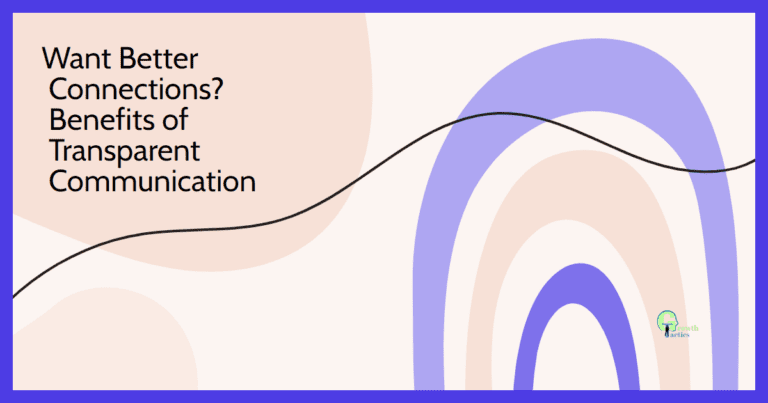Effective communication is essential for fostering strong connections and relationships, both in the workplace and in our personal lives. Within a professional setting, transparent communication plays a vital role in building trust, promoting collaboration, and improving overall performance. In this blog post, we will explore the concept of transparent communication in the workplace and discuss its benefits.
Jump To Section
Understanding Transparency in the Workplace
Transparent communication refers to the open and honest exchange of information, ideas, and feedback among individuals and teams within an organization. It involves sharing relevant information, insights, and expectations in a clear and timely manner.
What is transparent communication?
Transparent communication entails being open and upfront about decisions, actions, and challenges faced within the organization. It involves sharing information related to goals, strategies, changes, successes, and failures. Transparent communication helps to avoid secrecy and encourages a culture of trust and accountability.

Why is workplace transparency important?
Workplace transparency is vital for a variety of reasons. Firstly, it establishes trust and credibility among employees, which ultimately leads to stronger relationships within the workplace. When employees are aware of the decision-making processes and the reasons behind them, they feel more secure and are more likely to trust their leaders. This trust enables them to work together more effectively, leading to increased collaboration and productivity.
Additionally, workplace transparency fosters a sense of belonging and engagement among employees. When individuals are included in the decision-making processes and have a clear understanding of the company’s goals and strategies, they feel more connected and invested in their work. This sense of belonging not only boosts morale but also encourages employees to be more proactive and innovative.
Open dialogue and feedback are also promoted through workplace transparency. When employees feel comfortable sharing their thoughts and ideas, they are more likely to engage in problem-solving and innovation. This open exchange of ideas can lead to creative solutions and can help companies stay competitive in a rapidly changing business environment. Lastly, workplace transparency increases employee satisfaction and morale.
When employees feel valued and respected by their leaders, they are more motivated to perform well and contribute to the company’s success. By being transparent, leaders show that they value their employees’ opinions and contributions, which in turn creates a more positive and supportive work environment. Overall, workplace transparency is crucial in building trust, fostering engagement, encouraging innovation, and enhancing employee satisfaction and morale.
Building trust through transparent communication
Trust is the foundation of any successful relationship, including those in the workplace. Transparent communication plays a significant role in building and maintaining trust among team members and between employees and management. When there is trust in the workplace, team members feel safe and supported, which increases collaboration and productivity. Transparent communication is essential for establishing trust because it enables open and honest sharing of information, ideas, and feedback.
In a transparent communication culture, employees are more likely to feel valued and respected. They have access to important information about the organization’s goals, strategies, and decision-making processes. This knowledge helps them understand the bigger picture and align their efforts accordingly. When employees feel informed and involved, they are more likely to feel connected to the organization and its mission.
Transparency also fosters a sense of fairness and equality in the workplace. When everyone has access to the same information, it reduces feelings of favoritism or bias. This promotes a level playing field where employees can be confident that decisions are made based on merit and objective criteria.
Furthermore, transparent communication encourages open dialogue and feedback. It creates an environment where team members feel comfortable expressing their opinions, asking questions, and challenging ideas. This exchange of ideas leads to better decision-making and problem-solving as diverse perspectives are considered.
Additionally, transparent communication promotes accountability. When employees are aware of the organization’s expectations and goals, they can hold themselves and their colleagues accountable for their performance. Open communication also allows for constructive feedback, helping individuals learn and grow professionally.
On the other hand, a lack of transparency can lead to distrust, rumors, and misunderstandings. It creates a climate of uncertainty, where employees may question the motives behind decisions or actions. This can erode morale and hinder teamwork and collaboration.
To build and maintain trust through transparent communication, organizations should provide clear and consistent information to employees. This can be done through regular team meetings, company-wide updates, and open-door policies that encourage dialogue. It is also important to actively listen to employees’ concerns and address them promptly and honestly. Lastly, organizations should lead by example and ensure that managers and leaders are transparent in their communication and decision-making.
Overall, transparent communication is a critical component in building trust within a workplace. By fostering a culture of openness, organizations can create an environment where employees feel valued, connected, and motivated to contribute their best.

Best Practices for Transparent Communication
Effective and transparent communication is essential for fostering a positive and productive work environment. One of the best practices for achieving transparent communication is to establish clear communication channels. This can include regular team meetings, one-on-one conversations, and open-door policies that encourage employees to voice their concerns or ideas.
Active listening is also crucial to ensure that everyone has an opportunity to express themselves and be heard. Being honest and forthcoming in sharing information is another important practice. This means avoiding withholding facts or sugarcoating difficult situations. Instead, it is crucial to provide employees with all the information they need to make informed decisions and understand the expectations placed upon them.
Additionally, providing regular updates on organizational goals, strategies, and changes is essential to keep employees informed and engaged. This helps create a sense of transparency and trust within the workplace, promoting a collaborative and open communication culture.
The Benefits of Workplace Transparency
Transparent communication brings several benefits to the workplace:
- Trust and credibility: Transparent communication helps build trust among team members and between employees and management. When employees feel that they are being kept informed about important matters, they are more likely to trust their leaders and feel confident in the decisions being made.
- Increased productivity: When employees have a clear understanding of their roles, goals, and the overall direction of the organization, they can be more focused and aligned in their work. This clarity leads to increased productivity and efficiency.
- Improved problem-solving: With transparent communication, employees feel comfortable sharing their ideas, concerns, and feedback. This fosters a collaborative environment where everyone can contribute to problem-solving and innovation.
- Reduced conflicts: Miscommunication and misunderstandings often lead to conflicts in the workplace. Transparent communication helps prevent or resolve conflicts by ensuring that everyone has the same information and can voice their perspectives openly.
- Enhanced employee engagement and morale: When employees feel that their opinions are valued and their voices are heard, they are more engaged in their work and have higher morale. Transparent communication creates a sense of belonging and encourages a positive work culture.
- Better decision-making: Transparent communication allows for information to be shared openly, enabling employees and leaders to make informed decisions. When everyone has access to the relevant data and insights, decisions are more likely to be well-informed and accepted by all parties involved.
- Talent retention: Employees value transparency in the workplace. When they feel informed and included in important decisions, they are more likely to stay with the organization. Transparent communication helps attract and retain top talent.
- Customer satisfaction: Open and honest communication with customers builds trust and loyalty. When employees have a clear understanding of customers’ needs, they can provide better service and address any concerns effectively.
Overall, transparent communication creates a positive and productive work environment, leading to better relationships, improved teamwork, and positive outcomes for the organization.
Strategies to Foster Open and Honest Communication at Work
Now that we understand the importance and benefits of open and honest communication, let’s explore some effective strategies to foster this atmosphere:
Encouraging an Inclusive and Non-Judgmental Culture
Organizations should cultivate an inclusive environment where employees feel safe expressing their thoughts and concerns without fear of repercussion. This requires nurturing a culture that values diverse perspectives and embraces respectful disagreement.
Providing Platforms for Anonymous Feedback
Anonymous feedback channels allow employees to share their thoughts and concerns without revealing their identity. This can be particularly helpful for individuals who feel hesitant to speak up openly. Collecting anonymous feedback enables organizations to identify and address potential issues more effectively.
Promoting Active Listening Skills
Active listening plays a crucial role in open and honest communication. Encouraging employees to listen attentively and demonstrate empathy towards their colleagues fosters deeper understanding and rapport. Organizations can provide training programs to help employees develop active listening skills.
Conducting Regular Team-Building Activities
Team-building activities create opportunities for employees to interact, bond, and build trust. Fun and engaging events outside of the usual work environment help cultivate relationships and enhance communication among team members, laying the foundation for open and honest dialogue.
Conclusion
Transparent communication is vital for building strong connections and relationships in the workplace. By promoting openness and honesty, organizations can establish trust, enhance collaboration, increase accountability, and provide a more satisfying work environment. Embracing transparent communication as a core value will not only benefit individuals but also contribute to the success of the organization as a whole.


